10. Coneflower
The herbaceous perennial purple coneflower, Echinacea spp., is widely hybridized and available in an array of colors.
It grows in Zones 5 to 9 with full sun to part shade and may reach heights up to 48 inches.
Bloom time is late spring to fall. The large seed heads or cones attract late-season foraging songbirds. Pair with other late-season perennials, like asters and chrysanthemums.
‘Green Jewel’ has lime green petals surrounding a coordinating cone. It matures to a height of 20 to 24 inches.
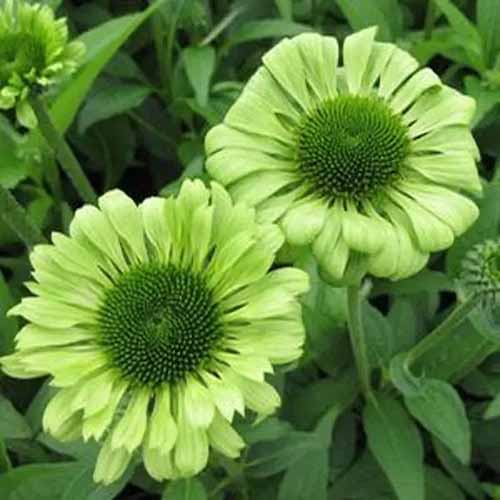
‘Green Jewel’ Coneflower
‘Green Jewel’ coneflower is available from Nature Hills Nursery.
See our guide to growing coneflowers for details.
11. Gladiolus
Tall spikes of ruffly, tubular gladiolus (Gladiolus spp.) blossoms add vertical interest to the garden in Zones 9 to 11 – they can be grown as annuals in more northern Zones.
They prefer full sun and bloom from spring to fall, and often require staking to remain upright at heights of 18 to 72 inches tall. Note that this is a toxic species.
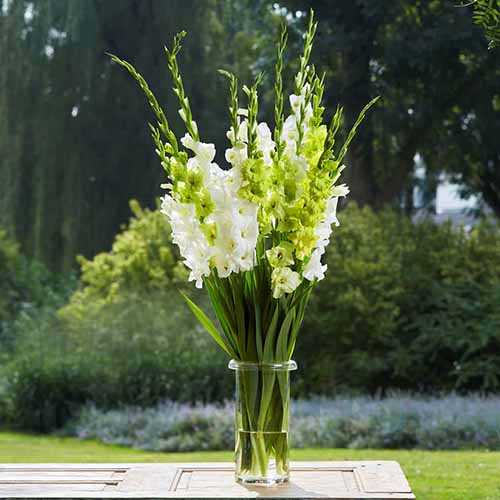
Green and White Mix Gladiolus
Eden Brothers offers a mix of lime and ivory blossoms that appeal to butterflies and hummingbirds, perfect for a cottage or pollinator garden.
You can find seeds for green and white gladiolus mix available from Eden Brothers.
Our guide to growing gladiolus has more information.
12. Hellebore
The nodding, cup-like blooms of perennial hellebores Helleborus spp., are a welcome sight at winter’s end.
Plants are hardy in Zones 4 to 9 and prefer part to full shade. Note that they are toxic.
H. odorus reaches heights of 12 to 24 inches and features fragrant sour apple to chartreuse blossoms.

Plants naturalize readily in shade gardens, woodland settings, beds, and borders, and they pair well with bleeding hearts and ground-covering, white-flowered sweet woodruff.
Learn more about growing hellebores in our guide.
13. Hydrangea
A woody hydrangea (Hydrangea spp.) shrub with flouncy old-fashioned blooms, is an eye-catching specimen in the landscape.
And when it has ethereal light lime blossoms, it infuses cottage gardens with softness and tranquility. Note that it is toxic.
Hydrangeas prefer full sun to part shade locations and grow to heights between three and ten feet.
H. arborescens ‘Limetta’ is a smooth hydrangea cultivar, suited to Zones 3 to 8.
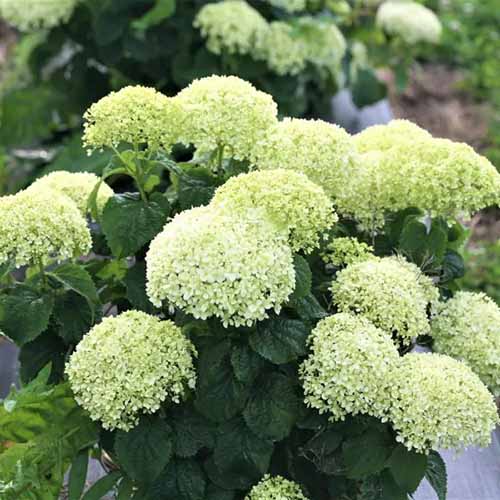
‘Limetta’ Hydrangea
Its petite three- to four-foot stature makes it well-suited to container gardening, or a position as an understory filler.
Blossoms open continuously from summer to fall in a lime green hue that ages to jade.
‘Limetta’ hydrangea is available from Nature Hills Nursery.
Consult our guide to learn more about growing hydrangeas.
14. Jack-in-the-Pulpit
Jack-in-the-pulpit, Arisaema triphyllum, is an herbaceous perennial wildflower that grows in Zones 4 to 9, where the shade is deep and the ground is moist. Note that it is toxic.
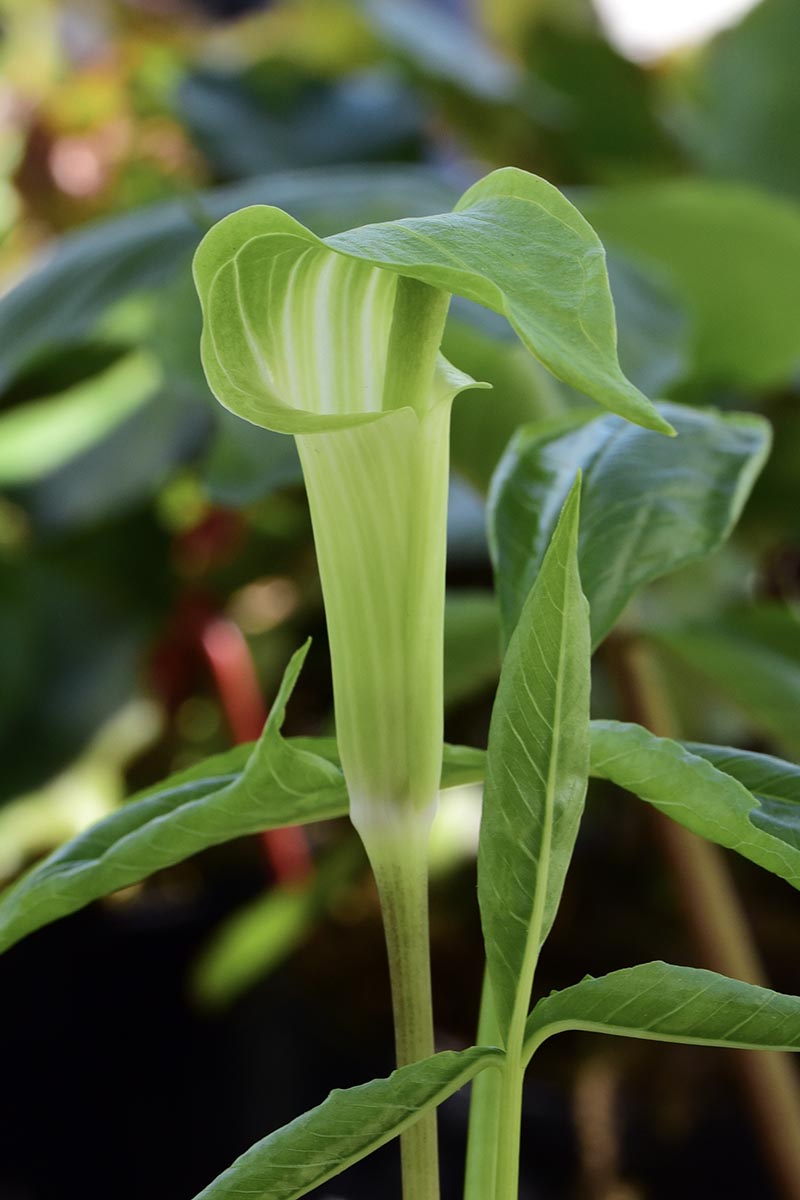
A companion to ferns, hellebores, and hostas, the blossoms consist of a leaf-green or maroon striped spathe enclosing a coordinating spadix.
It resembles a church preacher at a hooded pulpit. Mature heights are 12 to 36 inches.
See our guide to growing jack-in-the-pulpits for more information.
15. Lisianthus
Sun-loving lisianthus (Eustoma grandiflorum) aka prairie gentian or “lizzy,” has flared, bell-shaped flowers.
Lisianthus is an herbaceous perennial for Zones 8 to 10 that grows as an annual elsewhere.
It may take up to five months for the tiny seeds to mature and bloom. Starting them indoors accelerates the process. It blooms abundantly from summer to first frost.
These plants are a popular choice for bouquets and centerpieces. Mature heights are one to three feet, making them ideal as focal specimens with an old-fashioned cottage garden charm.
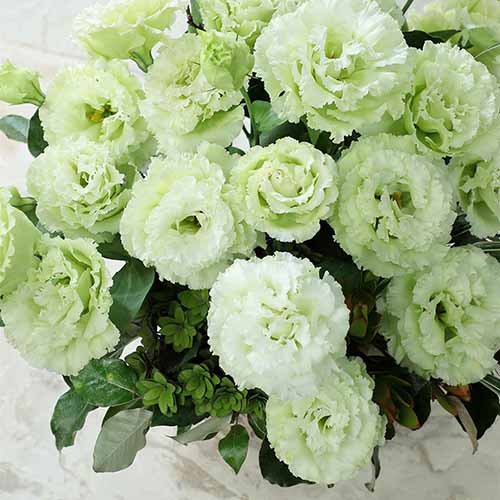
‘Voyage Green’ Lisianthus
The richly ruffled petals of ‘Voyage Green’ are a cool cucumber shade for an understated and nearly neutral addition to containers, borders, and beds containing annuals and perennials of various colors.
‘Voyage Green’ seeds are available from Eden Brothers.
16. Nicotiana
Flowering tobacco (Nicotiana spp.) is a perennial for Zones 3 to 10 that prefers full sun to part shade.
Small trumpet-shaped blossoms with long stems make excellent fillers in borders with spent spring bulbs. Mature heights range from one to three feet. Note that this is a toxic species.
Sweetly fragrant ‘Lime Green’ nicotiana is especially lovely interspersed with pink garden phlox and purple salvia.

‘Lime Green’ Nicotiana
The scent intensifies on cool evenings. Mature heights are approximately 24 inches tall.
‘Lime Green’ nicotiana seeds are available from Eden Brothers.
17. Ranunculus
Ranunculus (Ranunculus spp.), aka Persian buttercup, is a perennial bulb with rose-like, crinkled, multilayered petals and is a popular wedding bouquet flower.
It is suited to Zones 8 to 11, prefers full sun, and reaches mature heights of one to two feet tall. Note that it is toxic.
As the petals of’ ‘Super Green White’ unfurl, they reveal a center that looks a bit like a brussels sprout set in a ring of pale lime surrounded by bright white.

‘Super Green White’ Ranunculus
Best uses include mixed beds, borders, and containers with other green, pink, and white specimens.
‘Super Green White’ seeds are available from Eden Brothers.
18. Sunflower
The sunflower, Helianthus annuus, is an annual for Zones 2 to 11.
It prefers full sun and grows to heights of one to 12 feet, depending upon the type.
A ring of petal-like rays surrounds a center face of disk florets. At season’s end, the face is a rich source of seeds for people and/or birds to enjoy.
‘Sun-Fill Green’ is a hybrid sunflower that grows to a mature height of five to six feet.
It is noteworthy for its tea green calyx-like sepals that resemble the back of a typical sunflower and cluster around the center florets.
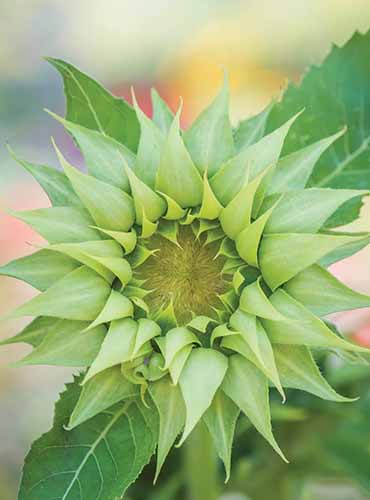
Sun-Fill Green Hybrid Sunflower
It is an excellent cut flower when the starry sepals are at their peak, as once it opens fully and runs to seed, the appearance declines.
Add this cultivar to the cutting garden alongside tall zinnias.
‘Sun-Fill Green’ seeds are available from Burpee in packets of 25.
Learn more about how to grow sunflowers in our guide.
19. Tulip
Spring-blooming tulips, Tulipa spp., are classic bulb flowers available in a rainbow of colors.
Green hues are synonymous with the season’s freshness and make pinks pop and whites appear crisper.
Hardy in Zones 3 to 7, they prefer full sun and grow to heights ranging from 4 to 30 inches, depending on the species and cultivar. Note that this is a toxic species.
‘Green Power’ is a Triumph tulip featuring bright lime flowers with a hint of rose at the margins and the traditional egg shape.
It is a late spring showstopper, especially when paired with hot pink tulips and hyacinths.

‘Green Power’ Tulip
Suited to Zones 3 to 8, this cultivar prefers full sun to part shade and reaches heights of 18 to 20 inches.
Green power tulips are available from the CZ Grain Store via Amazon.
Our guide to growing tulips has more information.
20. Viburnum
Viburnum, Viburnum spp., is a woody shrub generally grown in Zones 2 to 8 that prefers full sun to part shade.
It boasts clusters of springtime blossoms similar to those of hydrangea. Some species are toxic.
The Chinese snowball viburnum, Viburnum macrocephalum ‘Sterile,’ displays round blossom clusters that are chartreuse when they emerge and quickly shade to white.
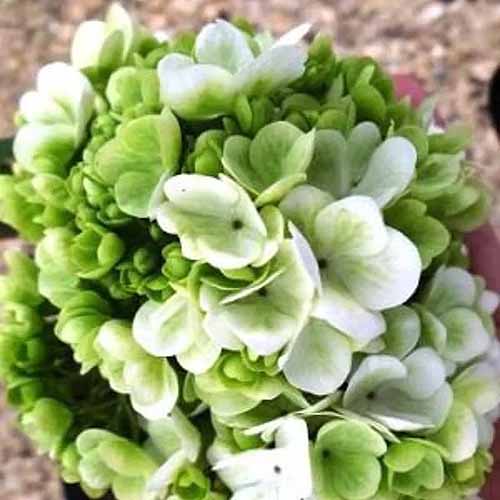
Chinese Snowball Viburnum
This one is suited to cultivation in Zones 6 to 9. Mature heights are six to ten feet tall for a substantial stand-alone focal specimen.
Chinese snowball viburnum is available from Nature Hills Nursery in #3 containers.
Check out our guide to growing viburnums for more details.
21. Zinnia
The zinnia, Zinnia spp., is a full-sun annual for Zones 3 to 10 with daisy-like petals in various richly saturated hues.
Tall types of this mid- to late-summer bloomer reach heights of up to four feet, while dwarf cultivars top out at a petite six to 12 inches.

‘Tequila Lime’ Zinnia
Zinnia violacea ‘Tequila Lime’ offers a mouthwatering shade of lime and substantial, rounded blooms with multiple petal layers. Plants top out at 48 inches.
Tequila Lime Zinnias are available from Eden Brothers.
Learn more about how to grow zinnias in our guide.
Unique and Unexpected
Green flowers are not your typical garden fare. In many cases, they are showstopping variations of familiar flowers that intrigue observers with their uniqueness.
With 21 to pick from, it’s time to take out your garden planner and decide where to incorporate some of these verdant blooms into your existing garden scheme.
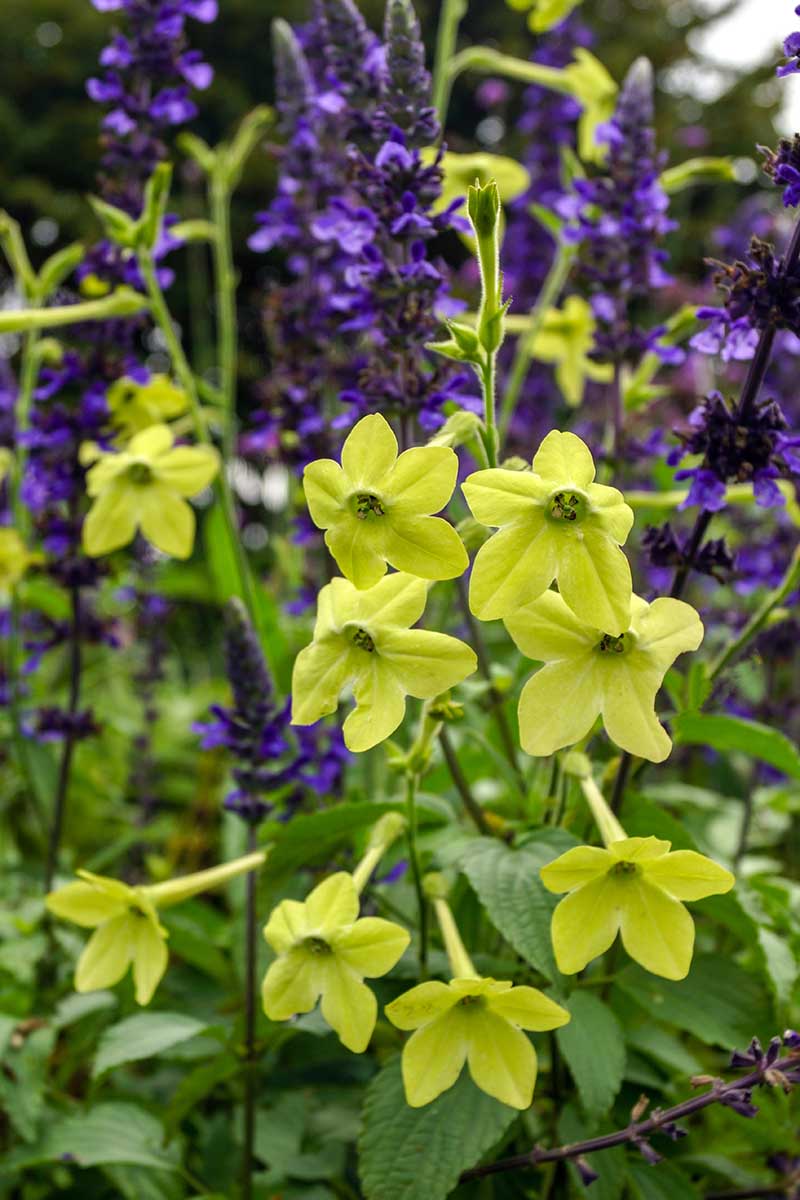
How about starry lime nicotiana paired with purple salvia?
Or maybe you’d prefer the vertical interest of emerald bells of Ireland among English daisies?
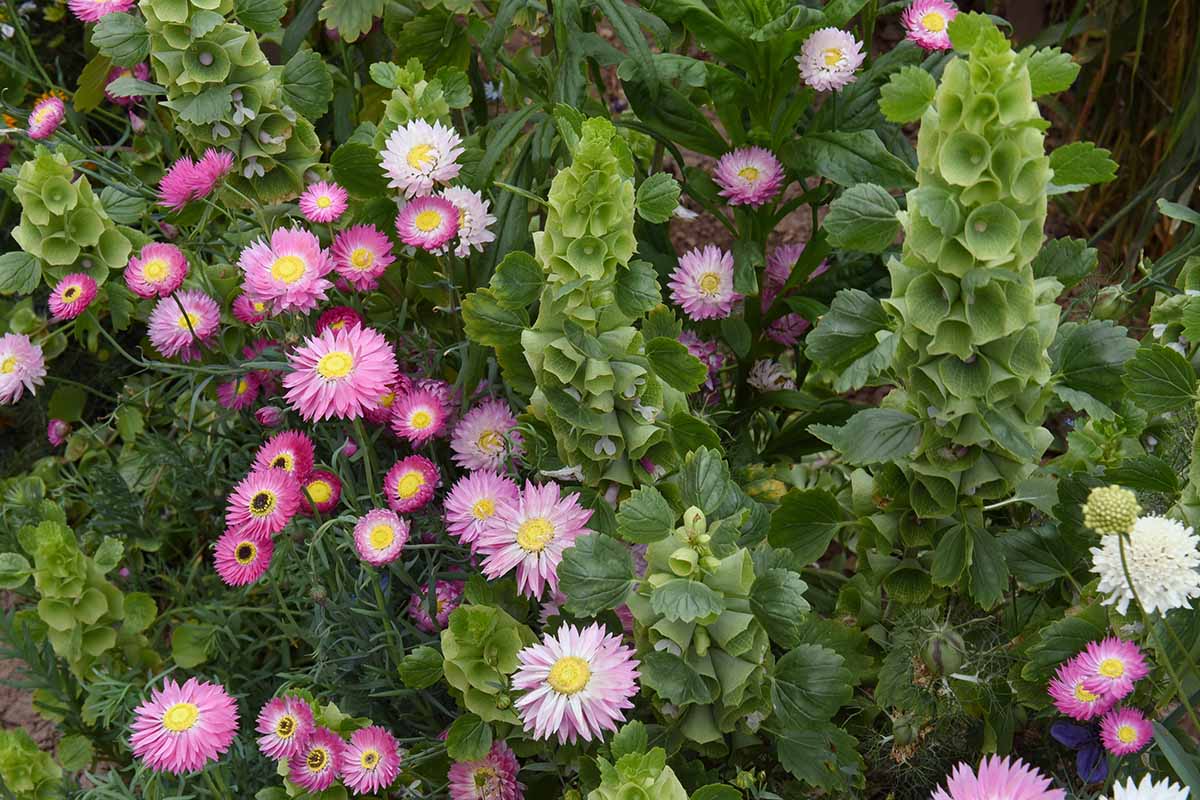
And surely every cutting garden has room for celery-hued zinnias to accent garden-fresh bouquets?
Contrasting companion flora show green blossoms to best advantage as unique and unexpected pops of color sure to delight you and visitors to your outdoor living space.
What are your most unusual garden flowers? Please tell us in the comments section below.
If you enjoyed this article and want to read more about flowers, we recommend the following guides next:

